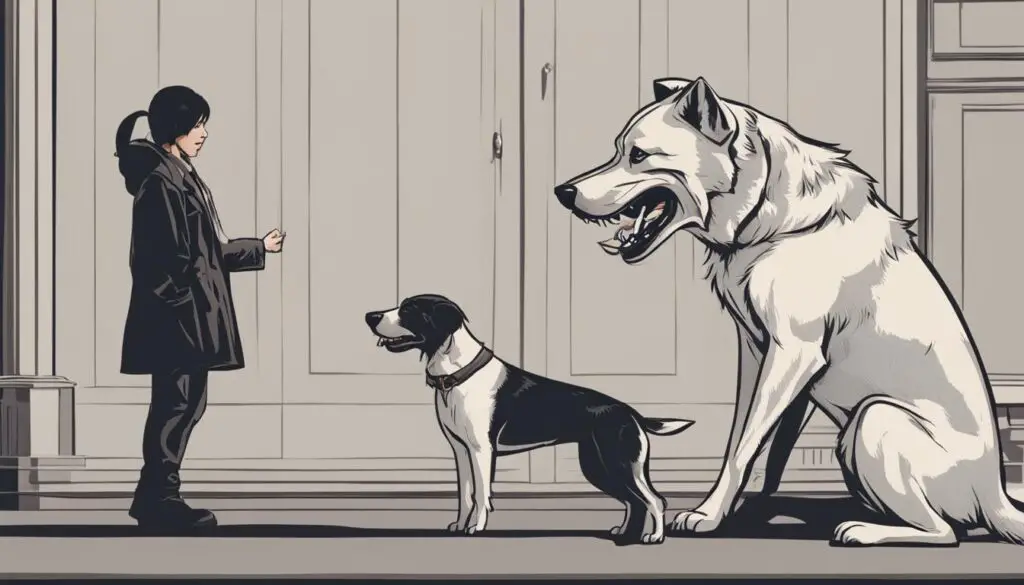As a pet owner, I have always been fascinated by the various vocalizations and sounds that my furry friends use to communicate with me. From barks and whines to growls and howls, each sound carries a different meaning and provides valuable insights into their emotions and needs.
By taking the time to understand and interpret these sounds, I have been able to build a stronger bond with my pets and meet their needs more effectively. In this article, I will explore the different vocalizations of pets and how we can decipher their messages.
Key Takeaways:
- Understanding your pet’s vocalizations can enhance communication and strengthen the bond between you and your furry friend.
- Dogs use barking, whining, growling, howling, and sighing to express their emotions and needs.
- Interpreting the context and accompanying body language is crucial in understanding the meaning behind pet sounds.
- Other pets, such as cats and birds, also have unique ways of communicating through sounds.
- Paying attention to the nuances of pet vocalizations can lead to improved well-being for both pets and their owners.
Deciphering Dog Barks
Dogs have a unique way of communicating through barking. Understanding the meaning behind their barks can help us better interpret their emotions and messages. Dogs use barking to express a range of feelings, including joy, fear, anger, awareness, frustration, and need. Interpreting dog barks requires considering the context and observing the accompanying body language.
“Barking is just another form of communication for dogs. It’s important to pay attention to the various aspects of a dog’s bark to understand what they are trying to convey.”
– Dog Behavior Expert, Sarah Thompson
When deciphering a dog’s bark, it’s essential to observe their overall behavior. A dog barking with a wagging tail and exhibiting playful behavior is likely expressing happiness and excitement. On the other hand, a dog barking aggressively with raised hackles may be indicating territoriality or a perceived threat.
The pitch of a dog’s bark can also provide insights into their emotions. Higher-pitched barks often indicate a welcoming tone or excitement, while lower-pitched barks may indicate a more threatening or aggressive tone.
Common Bark Interpretations:
| Bark Behavior | Possible Meaning |
|---|---|
| Continuous rapid barking | Alerting to a potential threat or danger |
| Short, high-pitched barks | Expressing excitement or anticipation |
| Deep, rhythmic barking | Signaling something unusual or unfamiliar |
| Single, sharp bark | Getting attention or calling for help |
| Prolonged, low-pitched bark | Expressing frustration or warning |
It’s important to remember that a dog’s bark is a form of communication, and it is their way of expressing their needs, wants, and emotions. By learning to decipher their barks, we can strengthen our bond with our furry companions and better understand their unique language of communication.
Understanding Whining in Dogs
Dogs often whine to communicate their needs and emotions. Whining can indicate a desire for food, attention, or to go outside. It can also be a sign of anxiety, fear, or pain. By paying attention to the context and accompanying body language, pet owners can decipher the meaning behind their dog’s whining.
For example, a dog whining at the door may be signaling a need to go outside, while a dog whining in the presence of a vet’s office may be expressing fear or discomfort.
It’s important to note that dog whining can vary in pitch, duration, and intensity, each conveying different messages. A higher-pitched whine may indicate excitement or anticipation, while a lower-pitched whine may suggest discomfort or distress.
Understanding the reasons for dog whining and interpreting dog whines can greatly improve the owner’s ability to respond appropriately to their pet’s needs. By actively listening and observing their dog’s whining, pet owners can provide the necessary care, comfort, or attention to address their dog’s concerns.
| Reasons for Dog Whining | Interpreting Dog Whines |
|---|---|
| Desire for food | Listen for higher-pitched, persistent whines. Check if it is time for feeding. |
| Need for attention | Notice if the whining occurs when the dog wants to play, be petted, or spend time with you. |
| Request to go outside | Pay attention to whining near the door or pacing behavior. |
| Anxiety or fear | Observe if the whining is accompanied by trembling, panting, or hiding. |
| Pain or discomfort | Look for signs of physical distress, such as limping, licking a specific area, or changes in appetite. |
By understanding the underlying reasons behind dog whining and taking appropriate action, pet owners can ensure their furry companions’ well-being and strengthen the bond between themselves and their dogs.
Decoding Dog Growls
Growling is a warning sign from a dog and can indicate feelings of fear, aggression, possessiveness, or playfulness. It is important to respect a dog’s growling as a form of communication and not punish them for it. Understanding the specific nuances of a dog’s growl, such as the pitch, intensity, and accompanying body language, can provide valuable insights into their emotions and intentions. For example, a low rumble growl may indicate alertness or hearing something outside, while a snarl with bared teeth may signify a strong dislike or a potential threat.
Learning to interpret dog growls is key to understanding their communication. Here are some common types of dog growls and their potential meanings:
- Playful Growls: These growls are typically accompanied by a wagging tail, relaxed body posture, and play bows. They indicate that the dog is excited and engaged in friendly play.
- Fearful Growls: Dogs may growl when they feel threatened or scared. When a dog is growling out of fear, their body language will generally be tense, ears pinned back, and tail lowered. It is important to approach a fearful dog with caution and give them space.
- Aggressive Growls: These growls are a clear warning sign of aggression. The dog may have a stiff body posture, raised hackles, and a direct stare. It is crucial to avoid provoking an aggressive dog and seek professional help if needed.
- Protective Growls: Dogs may growl to protect their territory, possessions, or loved ones. In this case, the growl may be accompanied by a defensive body posture and a focused gaze.
It is important to remember that each dog is unique, and their growls may vary in intensity and meaning. Paying attention to the context and the dog’s overall behavior can provide valuable insights into their growling communication.
The Meaning of Howling in Dogs
Howling is a natural behavior exhibited by dogs, and it can have various meanings and purposes. Dogs howl to communicate with their human companions, express their emotions, and even respond to other dogs’ howls. Understanding the significance behind a dog’s howling can help pet owners better interpret their furry friend’s needs and emotions.
One reason why dogs howl is for communication. When a dog howls, it can be a way of reaching out to their human companions or signaling their presence to other dogs in the area. Dogs have a unique way of vocalizing their needs and emotions, and howling is one of their methods of communication.
Another reason dogs howl is to express their emotions. Howling can convey a range of emotions such as loneliness, sadness, or excitement. For example, a dog may howl when they are feeling anxious or when they are experiencing separation anxiety. On the other hand, a dog may also howl when they are happy, such as when they see their favorite person or when they are playing.
In addition, dogs may howl in response to other dogs’ howls. This behavior is often seen in breeds like Siberian Huskies, who are known for their howling tendencies. When one dog howls, it can trigger a response from other dogs in the vicinity, creating a chorus of howls.
To better understand the meaning behind a dog’s howling, it is important to consider the context and observe the dog’s behavior. If a dog is howling persistently and appears distressed, it may be a sign that they are in pain or need attention. In contrast, if a dog howls briefly and then stops, it may simply be their way of making their presence known.
The Significance of Sighing and Groaning in Dogs
Dogs have various ways of communicating their emotions and needs, and one such method is through sighing and groaning. While these sounds may not be as obvious as barks or howls, they hold significance in understanding a dog’s state of mind.
Sighing and groaning in dogs can indicate different emotions such as contentment, disappointment, or relaxation. For instance, when a dog settles down for a nap, they may let out a long sigh or groan, expressing their comfort and satisfaction.
On the other hand, dogs may also sigh or groan when they feel disappointed or frustrated. This could happen when they don’t receive something they were expecting or when their desires are not met. It’s their way of letting us know that they wanted something different or didn’t get what they wanted.
It’s important to note that dog sighs and groans differ from human sounds. While humans may sigh or groan to express fatigue or dissatisfaction, dogs use these sounds to convey their emotions and needs. By observing the context and the dog’s overall body language, we can gain insights into their specific message.
For a better understanding, let’s explore the meanings behind different dog sighs and groans:
| Sigh or Groan Type | Meaning |
|---|---|
| Long, relaxed sigh or groan | Contentment and relaxation |
| Single, short sigh or groan | Disappointment or frustration |
| Repetitive or excessive sighs or groans | Possible discomfort or pain |
By paying attention to these audible cues and combining them with other forms of communication such as body language and facial expressions, we can better connect with our furry companions and cater to their needs.
Deciphering Other Pet Sounds
While dogs are known for their vocalizations, other pets, such as cats and birds, also have unique ways of communicating through sounds. Understanding and interpreting these pet noises can help enhance the bond between pet owners and their furry companions.
Cats: Purring and Communication
One of the most iconic sounds associated with cats is their purring. Cats often purr when they are content, but it can also serve as a communication tool with their humans. They may purr to express affection, when seeking attention, or even when they are injured or in pain. By paying attention to the context and accompanying body language, pet owners can decipher the meaning behind their cat’s purring and respond accordingly.
Birds: Vocalizations and Messages
Birds are incredibly expressive creatures, and their vocalizations can convey a wide range of messages. Different bird species have their unique repertoire of sounds, each with its unique meaning. For example, parrots can mimic human speech and use vocalizations to communicate their needs and emotions. Canaries have melodic songs that can convey happiness or contentment. Budgies use chirps and squawks to interact with their flock or humans. Understanding the specific sounds and associated behaviors of different bird species can provide valuable insights into their communication patterns.
Here is a summary of some common pet sounds and their potential meanings:
| Sound | Possible Meaning |
|---|---|
| Purring | Contentment, affection, seeking attention, or pain |
| Chirping | Excitement, happiness, or communication with others |
| Squawking | Alarm, distress, or dissatisfaction |
| Tweeting | Playfulness or seeking interaction |
Observing the context, body language, and overall behavior of your pets can provide valuable insights into the meaning behind their vocalizations. By actively engaging with and understanding their unique sounds, pet owners can strengthen their bond and create a more fulfilling relationship with their beloved pets.
Image: An image demonstrating the diverse ways pets communicate through sounds.
Conclusion
Effective pet communication relies on understanding and interpreting the vocalizations and sounds of our beloved pets. By observing their body language, context, and specific sounds, pet owners can decipher the meaning behind their pets’ vocalizations and respond appropriately. Whether it’s barking, whining, growling, howling, sighing, or other pet sounds, paying attention to the nuances allows us to better understand their emotions, needs, and desires.
By developing this understanding, we can establish a stronger bond with our pets and ensure their well-being. When we can accurately interpret their communication, we can address their needs promptly, reducing confusion and frustration for both pets and owners. Effective pet communication ultimately leads to a happier and healthier relationship between pets and their human companions.
So, the next time your dog barks or your cat purrs, take a moment to listen and observe. Through understanding pet sounds and vocalizations, we can create a language of our own with our furry friends. Let’s continue to nurture this unique bond and enjoy the joy, love, and companionship that comes with effective pet communication.
FAQ
What are some common vocalizations that dogs use to communicate?
Dogs use a variety of vocalizations, including barking, whining, growling, howling, and sighing, to express their wants, needs, and emotions.
How can I interpret a dog’s bark?
To interpret a dog’s bark, you need to consider the context, accompanying body language, and pitch of the bark. Higher pitches generally indicate a welcoming tone, while lower pitches suggest a more threatening tone.
What does a dog’s whining mean?
Whining in dogs can indicate a desire for food, attention, or to go outside. It can also be a sign of anxiety, fear, or pain. Paying attention to the context and the dog’s body language can help decipher the meaning behind their whining.
Is growling always a sign of aggression in dogs?
No, growling in dogs can indicate various emotions, including fear, possessiveness, or playfulness. It is important to respect a dog’s growling as a form of communication and not punish them for it. Observing the pitch, intensity, and accompanying body language can provide insights into their specific emotions and intentions.
Why do dogs howl?
Dogs howl for communication, expression of emotions, and in response to other dogs’ howls. It can be a way for dogs to communicate with their humans or announce their presence to other dogs. The context and behavior of the dog can help understand the reason behind their howling.
What do dog sighs and groans mean?
Dog sighs and groans can express contentment, disappointment, or relaxation. For example, a dog may let out a long sigh or groan when settling down for a nap or when they are disappointed. The context and overall body language of the dog can provide insights into the specific message behind their sighing or groaning.
Do other pets use vocalizations to communicate?
Yes, other pets like cats and birds also have unique ways of communicating through sounds. Cats may purr to express contentment or communicate with their humans, while birds have a wide range of vocalizations to convey messages like danger alert, emotions, or requesting attention.
Why is understanding pet vocalizations important?
Understanding and interpreting pet vocalizations is essential for effective communication with our pets. By observing their body language, context, and specific sounds, pet owners can better understand their emotions, needs, and desires, leading to a stronger bond and improved well-being for both pets and their owners.







No Comments